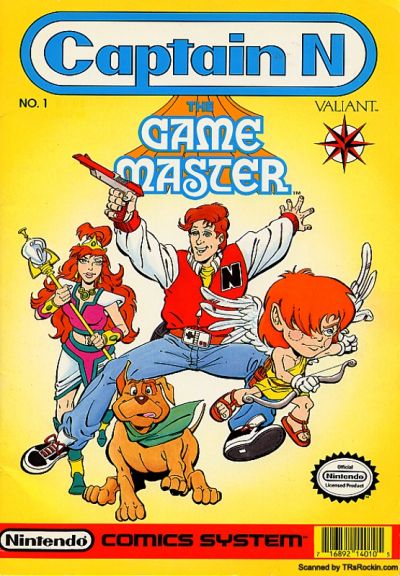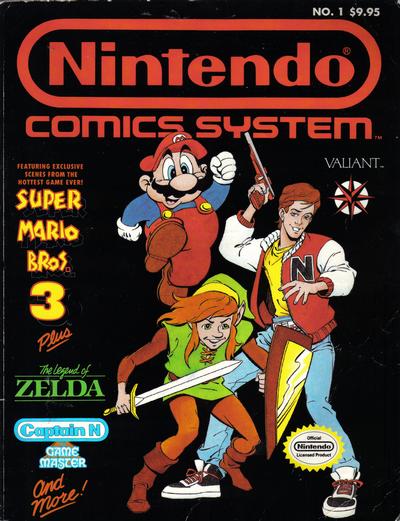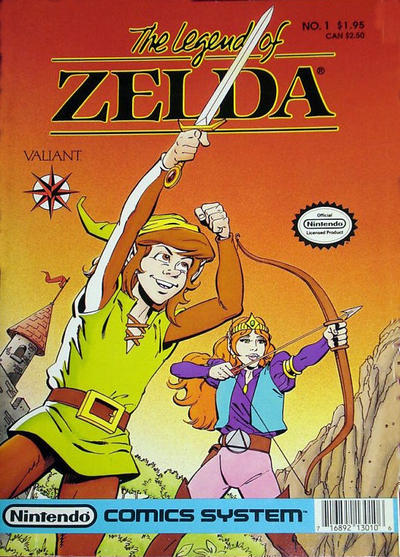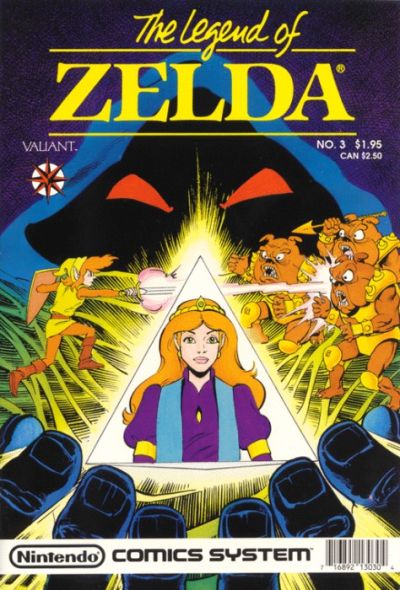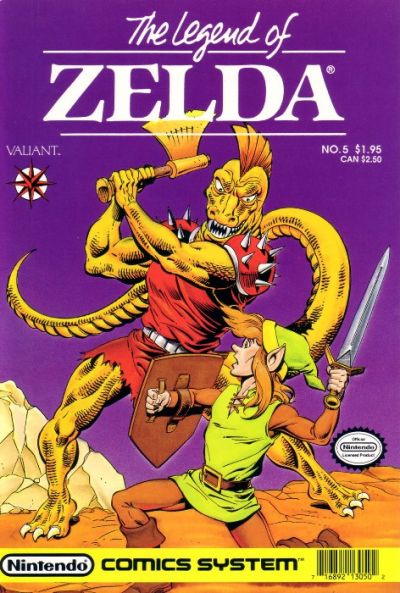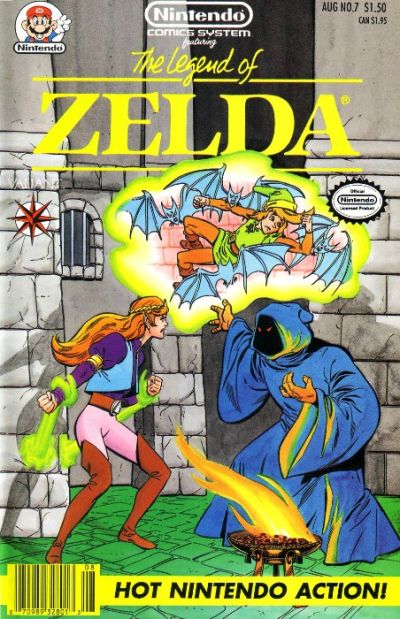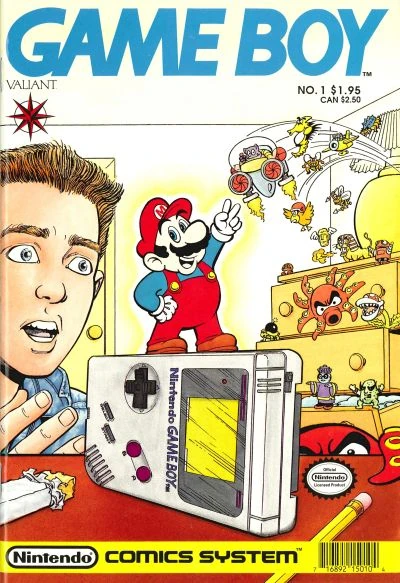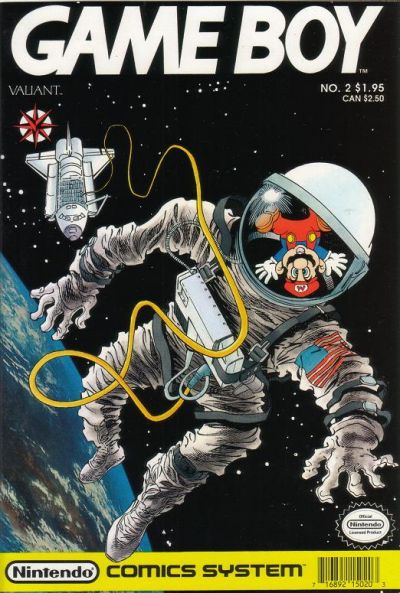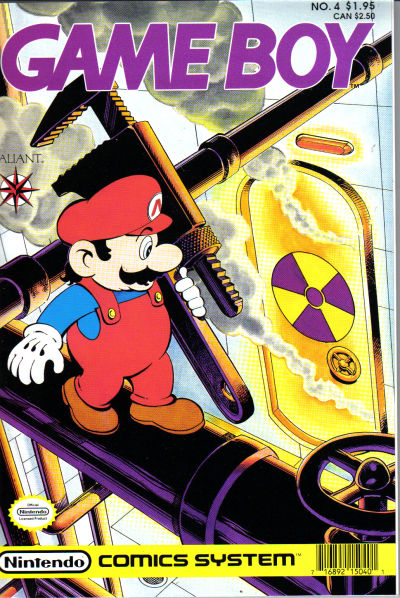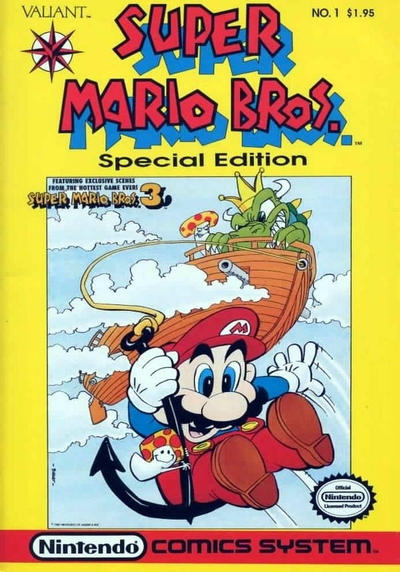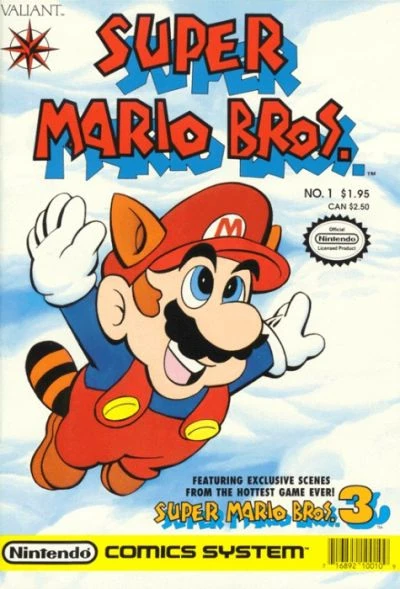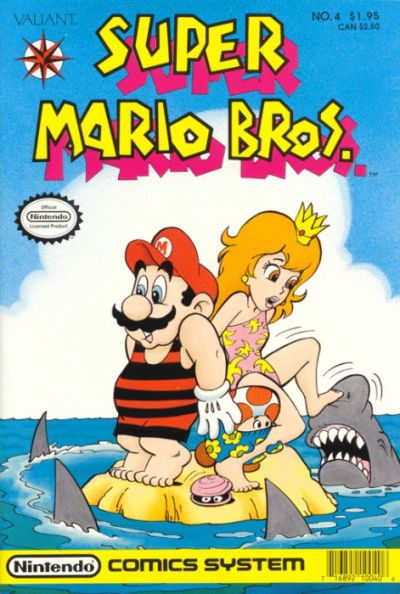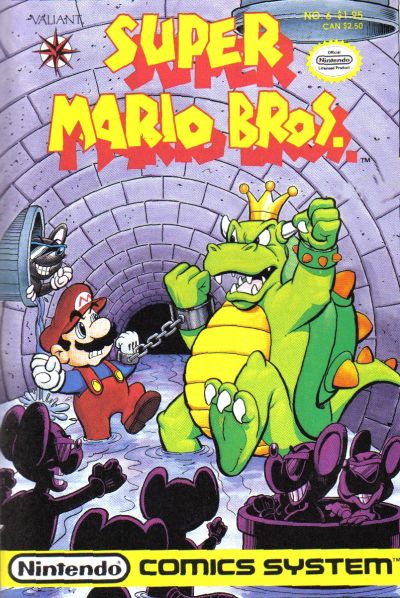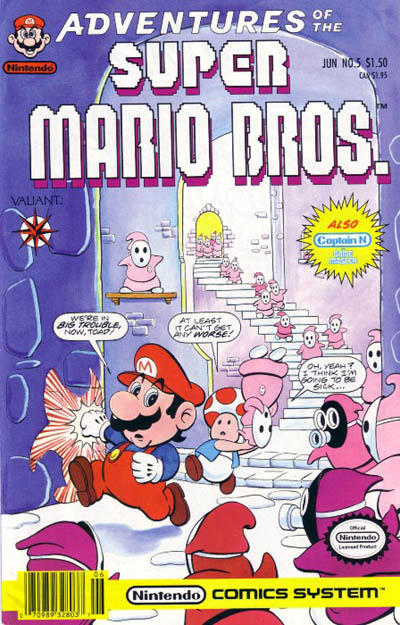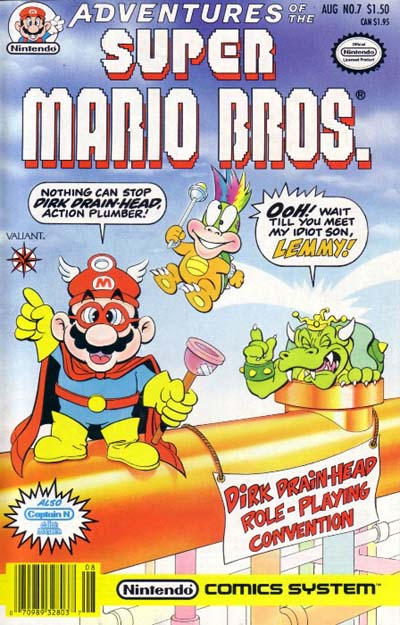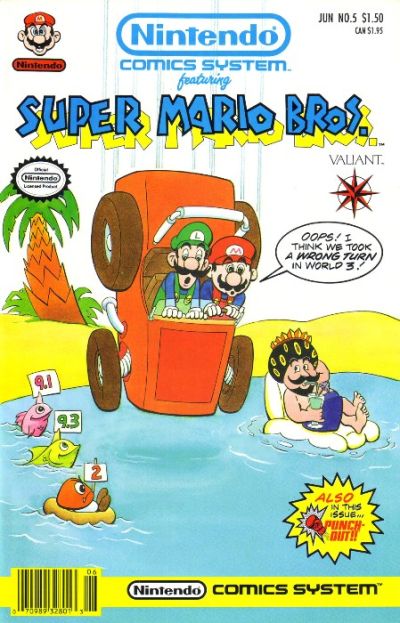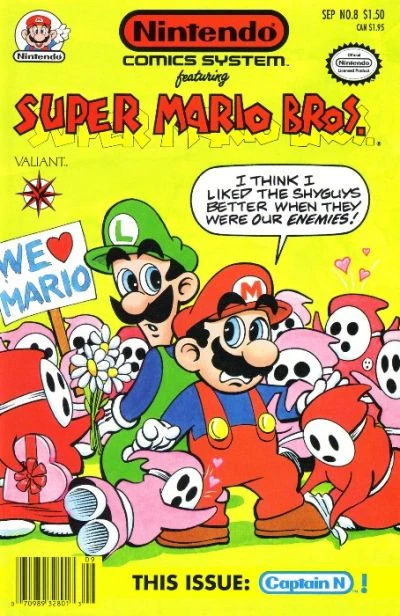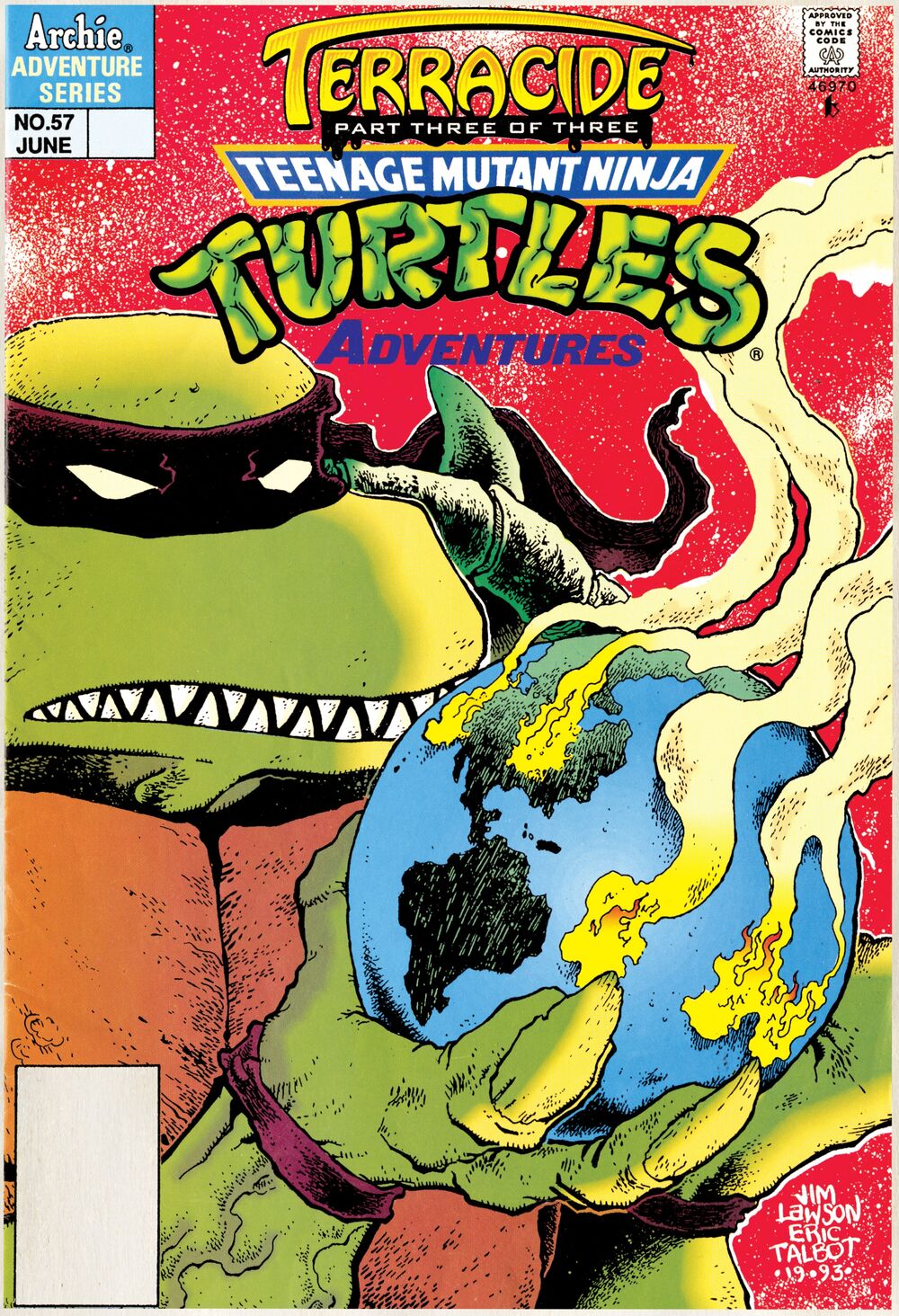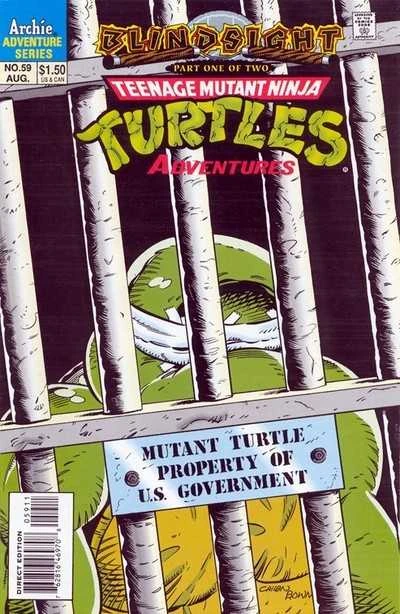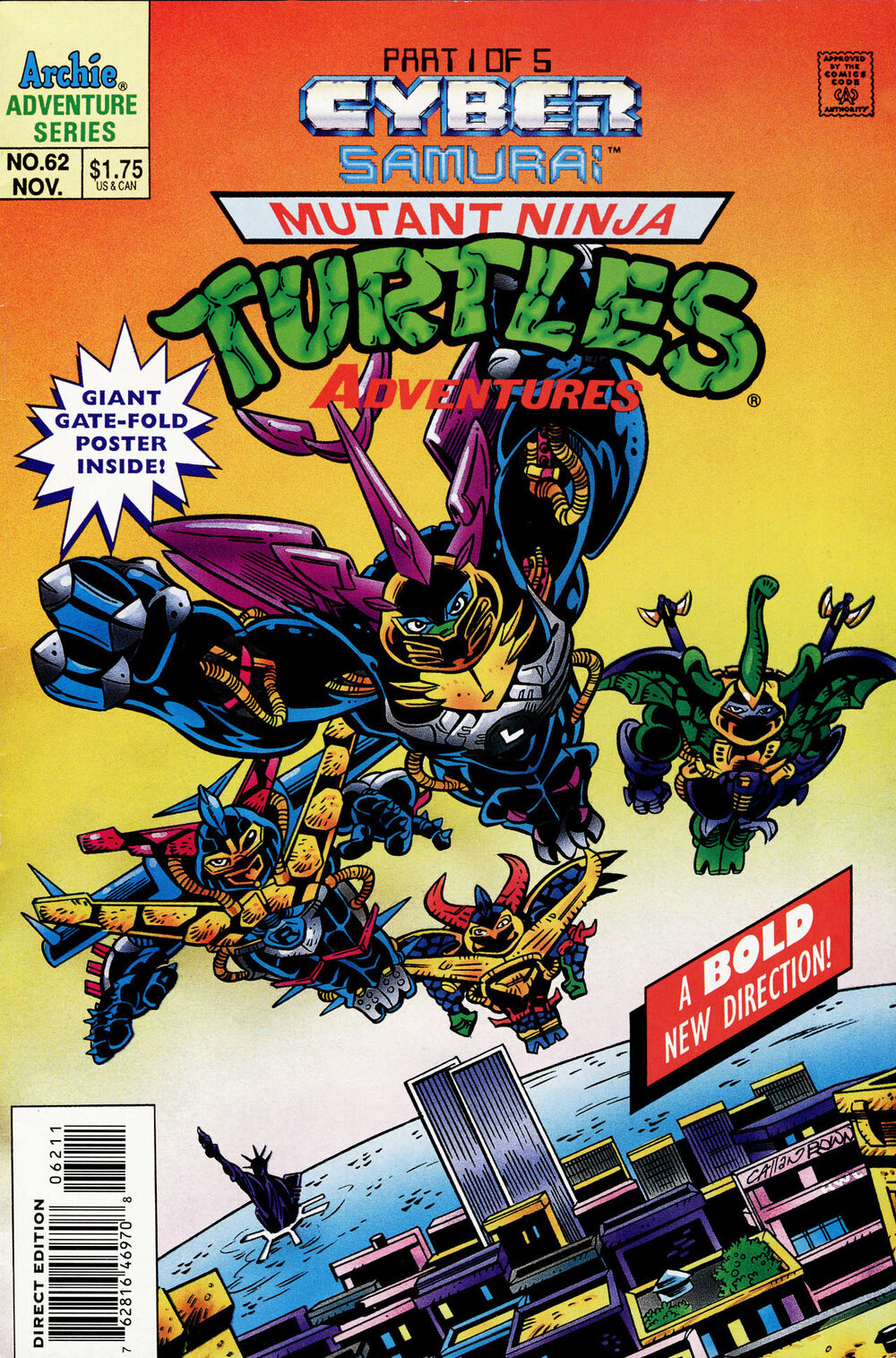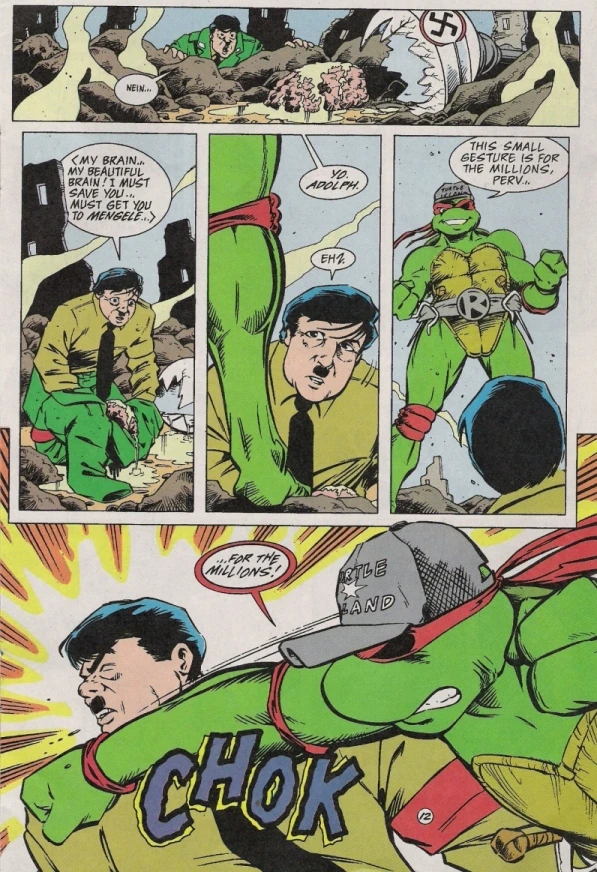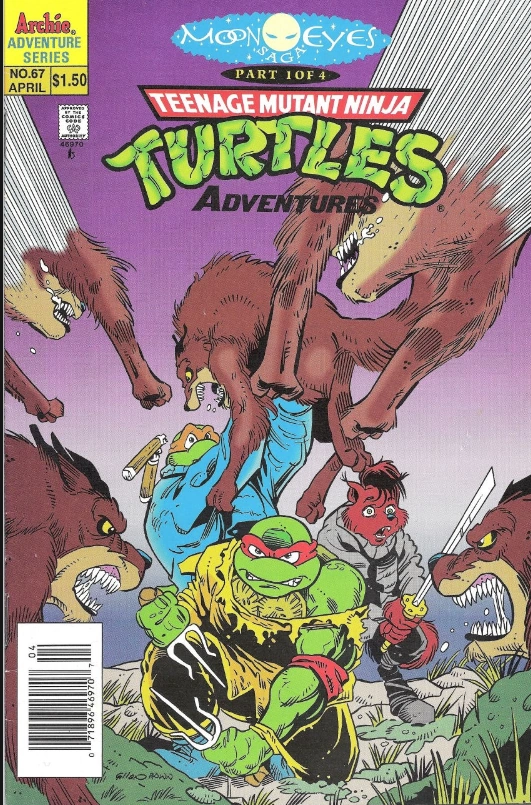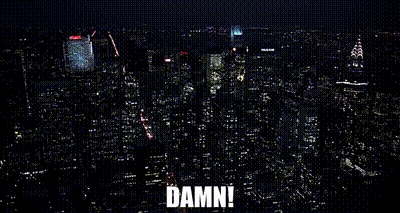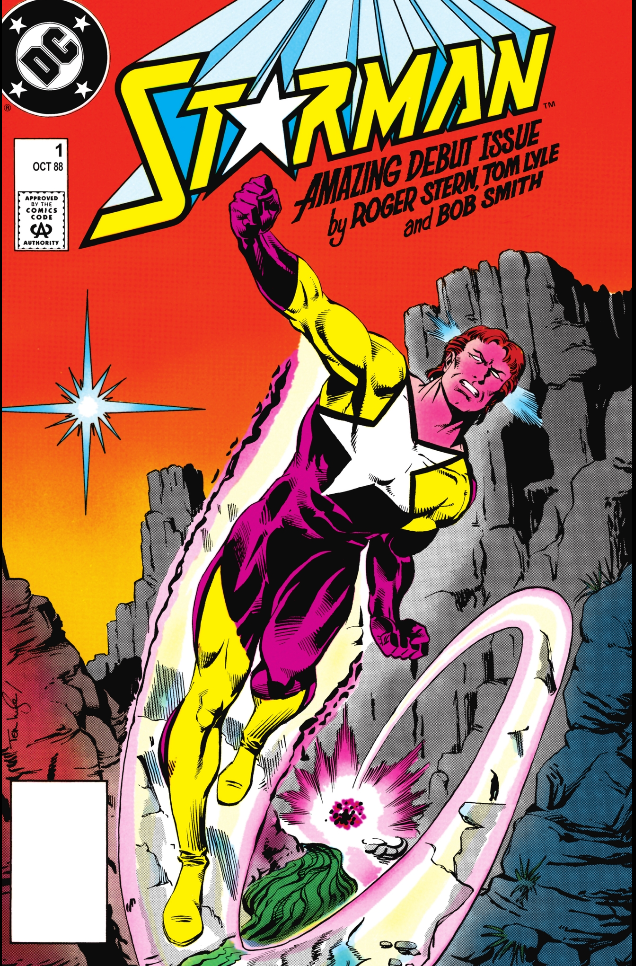Nintendo Comics System
Valiant Comics was founded in 1989 by former Marvel Comics editor-in-chief Jim Shooter, and one of the first things they managed to do was form a partnership with Nintendo and create the
Nintendo Comics System series of comics. The books were all released in 1990, almost all of them with a $1.95 cover price. I’m entertained by the house ads telling you to subscribe for 12 issues, given that none of the series made it a full year. The four titles were
Super Mario Bros, The Legend of Zelda (both obviously choices, as The Super Mario Bros Super Show had aired the previous fall),
Captain N the Game Master (which had also premiered the previous fall and would run for three full seasons), and
Game Boy (the hot new system which was released the previous summer).
As a video game fan and comics fan, I fell securely within the target demographic and I collected most of the issues. The revelation that
Archive.org had scans of a few issues I had missed inspired me to dig out and re-read the entire collection.
Captain N The Game Master (#1-5)
Kevin Keene (not to be confused with Archie’s Katy Keene or Kevin Keller) was a normal American teenager who played too much Nintendo, until one day when Videoland needed a hero and he was pulled through the Ultimate Warp Zone. Now he fights to keep the citizens of Videoland free from Mother Brain’s League of Darkness as Captain N, the Game Master. (And if you didn’t know that, the first two pages of the first issue recap it for you.)
The lineup from the TV show had to be edited because of rights issues, causing them to leave out Simon Belmont and Mega Man and instead use Kid Icarus (going by that name, instead of “Pit”) and Samus Aran. I talked specifically about Samus Aran’s appearances in this in
my Metroid 2 LP. So I apologize for re-treading it for people who read that.
This was a case where there was a gap in my collection: I originally only had issues #3-5, so the very first story was new to me when I found it on the Internet Archive.
So I got to read the very first story, “The Fruit and Vegetable War” for the first time, and it’s a pun-tastic romp through Cornucopia, a part of Mount Olympus where all the people are fruits and vegetables but have been manipulated into war by the evil Eggplant Wizard. (I actually have to wonder if it was independently conceived, or if it was intended to be a Princess Tomato in the Salad Kingdom story that had to be re-worked.) A two-page story sees Duke the dog fight off some skeleton warriors sent by Mother Brain and Uranos.
Then the second full story, “Money Changes Everything” introduces Samus Aran and reveals the original game’s big secret on the second page: Samus is a woman! And with that, the number of female regulars doubles and we set up the Betty-and-Veronica dynamic that will define every story Samus and Princess Lana both appear in. The story itself revolves around the gang heading to Zebes to prevent Mother Brain from getting a power source called Zeebetite, and Kevin showing off because he’s played Metroid a dozen times. (Zeebetite is the name of the tubes you need to destroy to reach Mother Brain in Metroid. Apparently they’re her power source, too.) Then it looks like Samus is willing to sell out the N-team to Mother Brain for money…but it’s all a trick to get both the money and the team out safely. Because Samus is a greed bounty hunter but she also has a heart of gold. And Mother Brain is as stupid as any 80s cartoon villain.
Note that in this case the setting of the game Metroid is named “Metroid” instead of SR388. I feel like that was a common misconception at the time, and I’m not sure if the writers just assumed it or deliberately ran with it because they figured kids wouldn’t recognize SR388. (Several issues later, as we’ll see, they establish that the space pirates have a new base named “Metroid” after Samus destroyed their original one.)
In the second issue, Princess Lana is kidnapped by Uranos, and put in “The Happy Zone”, a place of no escape. Mother Brain tries to lure Kevin there with a chance to join her, but allowing her armies to conquer videoland in the process. Kevin resists, defeats the army, and threatens to smash Mother Brain’s jar and kill her. Faced with that prospect, Mother Brain reveals that Lana can be freed and does so, but escapes afterwards. The final panel is sufficiently vague that Lana and Kevin might be kissing or just hugging.
Then we have a goofy two-pager of “Villian Dos and Don’t” and a one-pager where Mother Brain is delivered “the item”, an object that looks like a horrible torture chair and is apparently used to give her a facial. I don’t know, that one really doesn’t work.
The second story, “Just A Dog,” establishes a rivalry between Duke the dog and Kid Icarus, which is mostly Kid Icarus being a jerk. They get into a fight with the Eggplant Wizard’s new mysterious samurai army, but when they get defeated, Duke saves them…by being a dog, because the samurai are secretly cat-people and hate dogs, so they walk off the job. This is a particularly dumb resolution, because the day is saved by a dumb coincidence and it doesn’t actually resolve the “Kid Icarus thinks dumb dogs are useless” conflict.
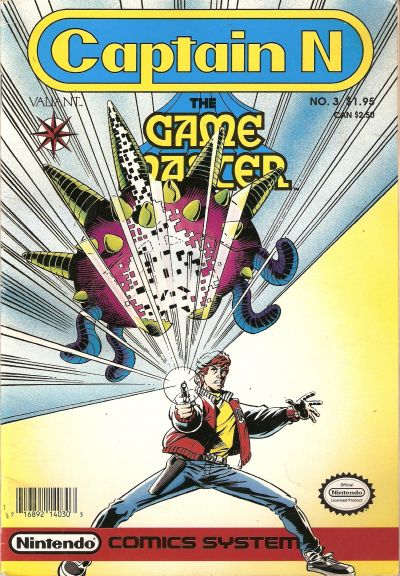
The third issue opens with the Palace computers going haywire and threatening a reactor meltdown. Eggplant Wizard and inexplicably-blue King Hippo have spread a gooey glowing purple liquid “computer virus” into the systems, but due to their incompetent bungling Mother Brain is infected, too. Fortunately, the N-team comes to Metroid and uses a shrink ray to get inside Mother Brain’s mind (it turns out that, at least in Videoland, if you shrink into somebody’s brain you can get small enough to interact with their inner thoughts). They discover a strange girl fighting off all the evil monsters and memories who helps them locate the antidote to the computer virus. When they escape, Kevin deliberately saves Mother Brain’s life, because now that he knows that there’s good in her he has hope that it’ll someday win.
On one hand, the “computer virus” being a glowy liquid or the idea you can shrink into someone’s thoughts is ludicrous. On the other hand, in Videoland this actually isn’t unreasonable. It isn’t the real world and it isn’t uniquely tied to any specific video game’s logic or lore. In theory, anything that can happen in any video game can happen there. So this plot actually seems pretty viable.
A two-pager shows “The Fabulous Powers of Captain N”, explaining how all of Kevin’s gadgets work. It’s really a shame he never had a Power Glove or a R.O.B. There’s also a one-page splash introducing Video-Town, the setting of the next story.
The second full story is “A Dog’s Life”, when Kevin and Duke accidentally switch minds by messing with the Power Pad inside a warp zone. Kid Icarus maintains his rivalry with the dog while Princess Lana demonstrates sitcom levels of obliviousness. The secret weapon Mother Brain gave King Hippo was a brain-zapper that makes people really stupid, and I bet you can guess that it doesn’t affect Duke-in-Kevin because he’s got a dog’s brain already. Kevin-in-Duke saves the day by defeating King Hippo and mashes the Power Pad to switch them back as they warp home.

The fourth issue opens with “The Real Game Master”, in which Kevin’s plans are ruined because of new monsters he’s never seen before. This is a commentary on Kevin’s actual skill as a game master: It’s not that he’s particularly clever or talented, he just knows everything about video games because he played them all. Which is also a meta-commentary on action games of that era, where memorizing patterns, secrets and surprises was often much more important than reflexes. It turns out that the new monsters were created by Mother Brain’s new hologram machine, and her next trick is to use it to create a fake Game Master to split up the N-team. Fortunately, Kevin’s ability to memorize video games means he notices the strange new machine in Mother Brain’s chambers when he’s lured there, and he destroys it, foiling the plot.
The two-page “Secrets of the Warp Zones” explains how they work and guest-stars Pluton the Robbing Orc and Donkey Kong. A one-pager introduces Prisonworld, planet RX338.
Then our next story, Breakout” opens with Captain Dare of the Federation Police showing up at the palace to arrest Princess Lana. It turns out that she’s been charged with all of Mother Brain’s crimes, and when Samus tries to object, Judge Ridley throws them both in prison. (This is, of course, all a sinister plot by Mother Brain.) Samus beats up a bunch of space pirates who come look for revenge, and forces Kraid to act as bait for her escape. Meanwhile, Princess Lana tells off an abusive guard and rallies the prisoners to improve their conditions. Samus briefly considers leaving without Lana so she can have Kevin’s affections to herself, but she’s too honorable to go through with it. By the time Kevin finds out what was going on an frees the real judge, Samus and Lana have already escaped and Lana is making plans to force them to improve conditions for the prisoners. When Kevin leaves again, they agree to complete fairly for Kevin’s affection.
It's interesting that the TV show focused a lot on Kevin and Simon competing for Lana, and this swapped it to Lana and Samus competing for Kevin. Gotta have that love triangle!
This issue opens with “A King of Shreds and Patches.” On the eve of Princess Lana’s birthday, a surprise attack knocks Kevin into the chute to Garbageworld. Samus has a portable space-time warp she’s itching to try out, so she volunteers to rescue him. The warp malfunctions and instead of arriving fifteen minutes later, she arrives after Kevin has spent 15 years ruling Garbageworld, the last free kingdom in Videoland. He invites Samus to stay and be his queen. She is briefly enticed, but realizes that the freedom of Videoland matters more than her chance to be with Kevin, so she warps back and prevents him from falling.
A one-pager tells us more about Garbageworld, then we get a two-page spread of Samus’s ship, the Hunter IV. (This was wholly from the minds of the writers and doesn’t appear in any video game. And the influence of the Star Trek Tech Manual on it is very obvious.) Then we get a second one-pager about The Locker, a safehouse space station for bounty hunters.
Which leads into our second story, “When Friends Fall Out.” Kid Icarus was turned to stone by a Gorgon, and a Medusa Ray Samus has in her storage at The Locker might be able to be reversed to restore him. Lana spots a Flame-Chip in the locker and is convinced that Samus received it as payment for kidnapping Lana’s missing father, King Charles. Kevin isn’t sure, so Lana conks him, steals the Zapper and goes after Samus herself. After an extended fight scene, Samus reveals that she was kidnapped by space pirates and hooked up to a brainwashing machine, and had the flame-chip when she woke up, but has no idea what happened in the interim. Kevin talks Lana down and convinces her that whatever happened, Samus is their friend. In the epilogue, the consciousness of the flame-chip reveals to Duke the dog that Samus broke free of the machine, grabbed the flame-chip and semi-consciously flew them both to safety. (Implying also that King Charles was kidnapped by space pirates and they received the flame-chip as the reward.)
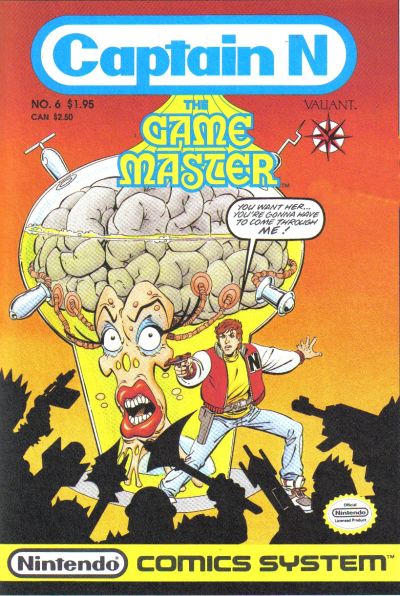
The series was cancelled after #5, so though cover art was done, #6 was never published. We’ll never know why Kevin was protecting Mother Brain. And we’ll never know if Lana or Samus wins Kevin’s affections. I suspect that there’s a desk drawer somewhere with a pile of notes on Betty-and-Veronica stories and goofy one-off gimmicks.
Though this isn’t the end of the Captain N story! There are two Nintendo Comic System omnibus books that have additional stories. These were clearly a some mix of testing out the larger format and also an advertising for the individual series; and they had new stories, not reprints, which is particularly impressive.
The first volume had the crazy cover price of $9.95 for a 48-page oversized book. I’ll talk about the Mario and Zelda stories when I go through those books, but the rest make more sense here. The Captain N story is actually preceded by a reprint of the two-page “Welcome to Videoland” intro from Captain N #1. Then there’s a proper N-team story titled “All’s Well that Ends Swell”. The team is in Kongoland looking for the Well of Despair, which apparently holds an ultimate weapon at the bottom of it. The well, however, is really a psychological test that teaches you that the ultimate weapon is patience; which Kevin learns after persevering against despair.
Then we have a pair of Punch-Out stories, an intro titled “The First Fight,” and a full story called “Outsiders.” Little Mac never appears in the Captain N stories, but King Hippo does, so this is logical to note here. In this, Little Mac is slated to fight Piston Honda, but when he learns that Honda is going to use the money to build a school in a poor Japanese village, he’s tempted to throw the fight. Honda is angered by this and reminds Mac about the importance of honor, so Mac wins the fight and gives the prize money to Honda’s coach for the school anyway. (This is the sort of story that you could only get in a kids comic in 1990—it assumes the reader has basically never heard of Japan or anything Japanese, and has some very impressive orientalism going.)
The second volume is much more reasonably priced at $4.95, but is also cut down to 32 pages. After another reprinting of “Welcome to Videoland”, we have the Captain N story “The Master Machine.” Princess Lana has installed a Master Computer System to control all of the palace defenses, but Kevin is skeptical. Which turns out to be correct when a strange energy bolt reprograms the computer to think that Mother Brain is Princess Lana, and vice-versa. When the League of Darkness attacks, the defense system captures ad incapacitates Lana, so Kevin thinks fast and challenges the system—figuring correctly that a video game computer will act like a video game computer. It gives him 15 minutes to defeat the palace defenses and save the Princess. He wins, of course, but then Mother Brain arrives. She disables the palace defenses, but Kevin uses his pause button at the last minute to turn the tables, drives her off, and kisses Lana back to wakefulness. (Yeah, I know. They were going for a “Sleeping Beauty” moment. Given that the other stories seem to indicate that Kevin and Lana are non-exclusively dating in some capacity, this isn’t terrible, but I still wouldn’t expect to see it nowadays.)
Then we get a Punch-Out reprint of “The First Fight” as a lead in to “Fox and Hounds.” A rich woman named Vonnie watches Little Mac beat Super-Macho Man and introduces him to lifestyles of the rich and famous, despite Doc’s objections. Vonnie’s ex Reg pays off Super-Macho Man to ambush Mac and seriously injury him, but Doc saves Mac at the last minute. Mac goes on to win the fight, but Reg’s actions make him realize the rich people only think he’s a sideshow and don’t actually care about him, so he heads back to his old life. Vonnie, heartbroken because she apparently really liked Mac, punches out Reg. What’s the moral? Some rich people are assholes, but some just have poor communication skills.
Finally, we have a several Metroid stories: The two-page “The Coming of a Hero” that introduces Samus Aran as a former star space cop who mysteriously quit and disappeared, but then reappeared as the galaxy’s most fearsome bounty hunter. Then we have a one-page introduction to “Metroid” a mobile asteroid base build by the space pirates to allow them to travel far from Zebes. Finally, “Deceit Du Jour” is the real story, where Mother Brain hires bounty hunter “Big Time” Brannigan to find the intruder in her base. (I love Big Time’s character design—he’s a bug-creature who look humanoid but his body cuts off at the waist, so his two large arms also function as legs. He’s constantly balancing on one to fire his one-handed energy cannon.) Samus and Big Time fight and it seems like Big Time gets the upper hand, forcing Samus to surrender and give up her handgun. But Samus outsmarts him, and booby-traps her gun to explode when he tries to shoot her, allowing her to escape and leaving him to Mother Brain’s displeasure.
While the Metroid stories don’t directly reference Captain N, it’s very clear they’re in the same universe and that’s the same Samus. Meanwhile, the Mario and Zelda stories make no reference to Videoland and the N-team never visit those worlds. There were three major tentpoles to the Nintendo Comics System, but they didn’t interact with each other.
The Captain N comics generally avoided tie-ins to actual video games (probably because of rights issues), where the cartoon show leaned very heavily into a “game of the week” format. The comic writers clearly found the Metroid sci-fi world most interesting and built out from there, making up new planets within the Galactic Federation to use as setpieces.
Most of the stories were scripted by either Bryan D. Leys or George Caragonne, though this was clearly a team effort and they were at least trying to keep points like the various rivalries consistent. The art team also was piecemeal, but you wouldn’t know it, because they all hewed very closely to a well-done house style.
(More posts to come.)
